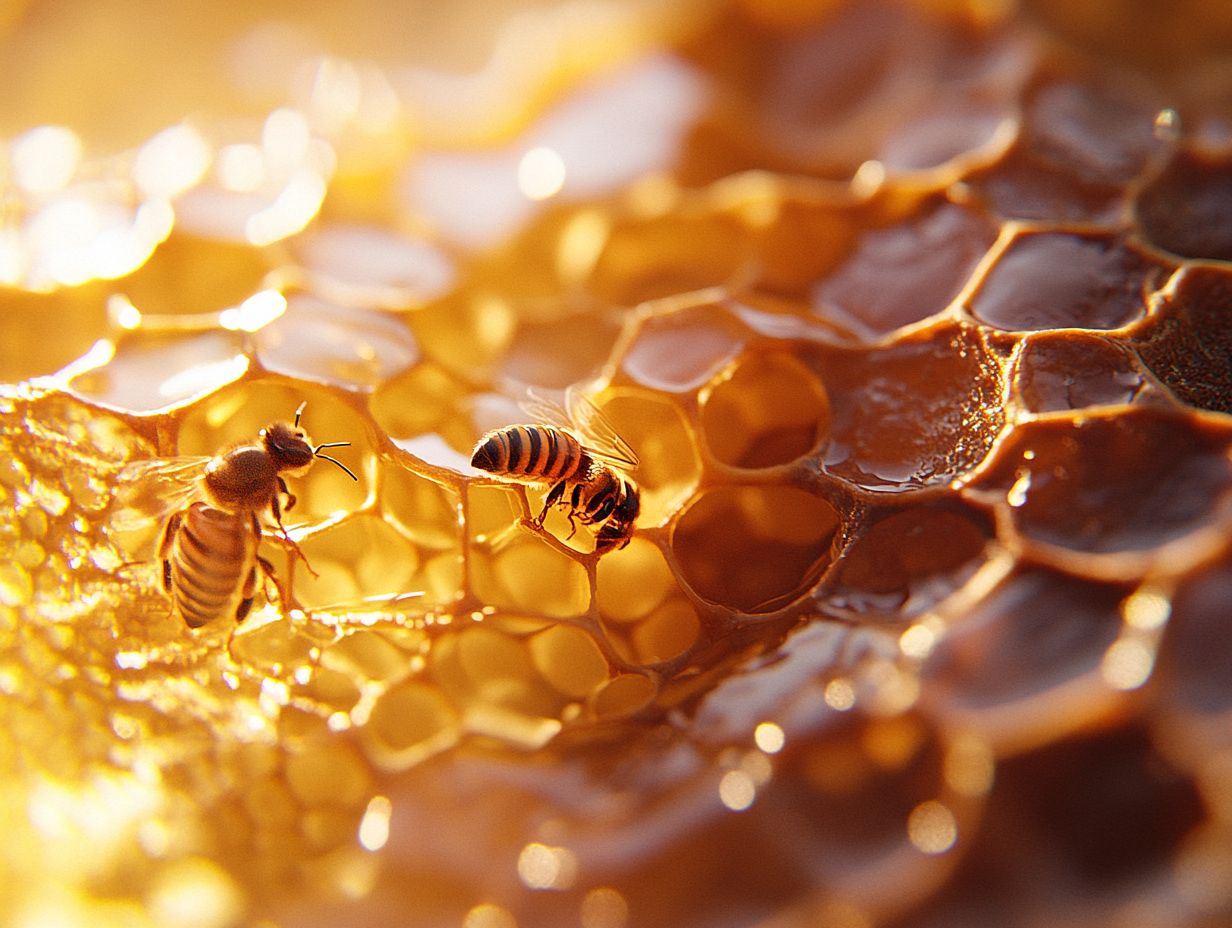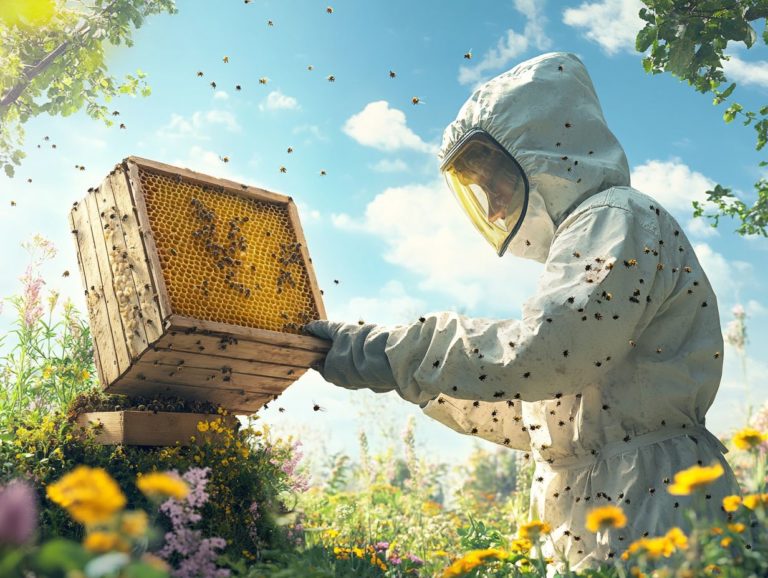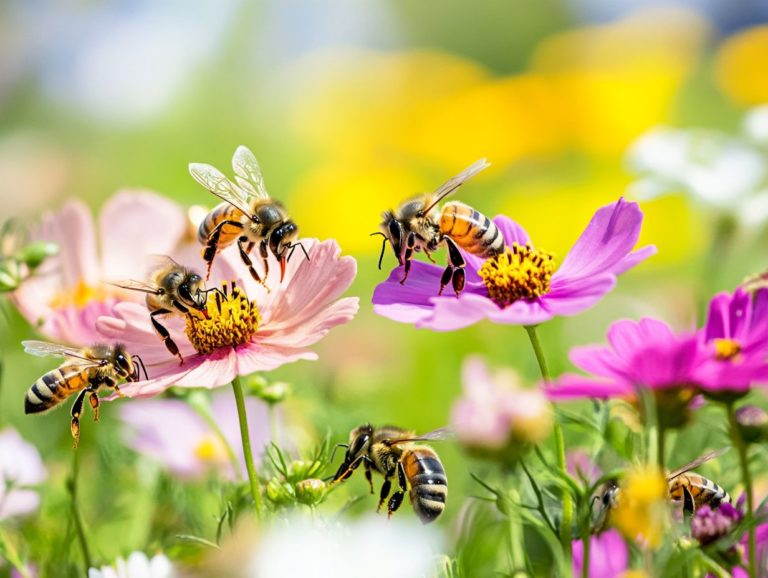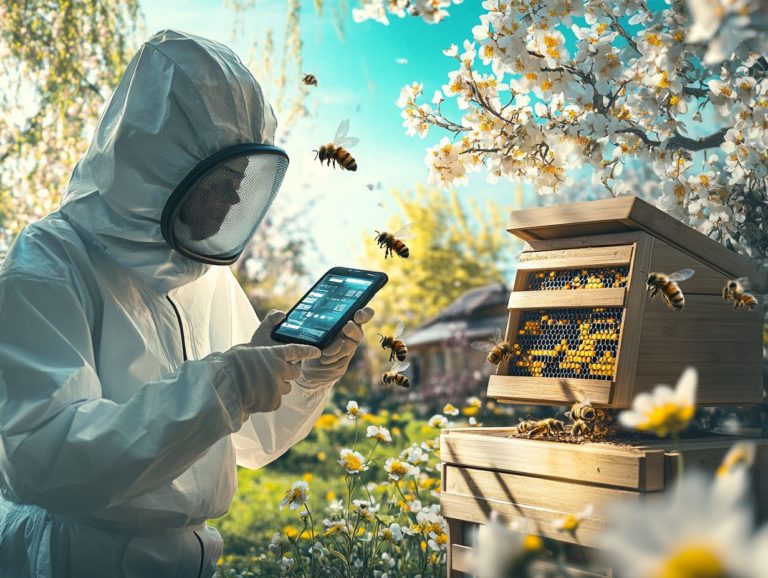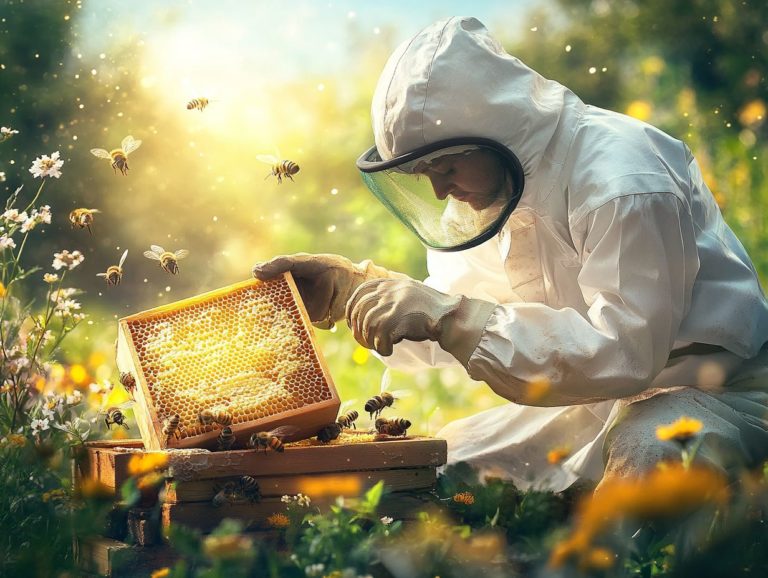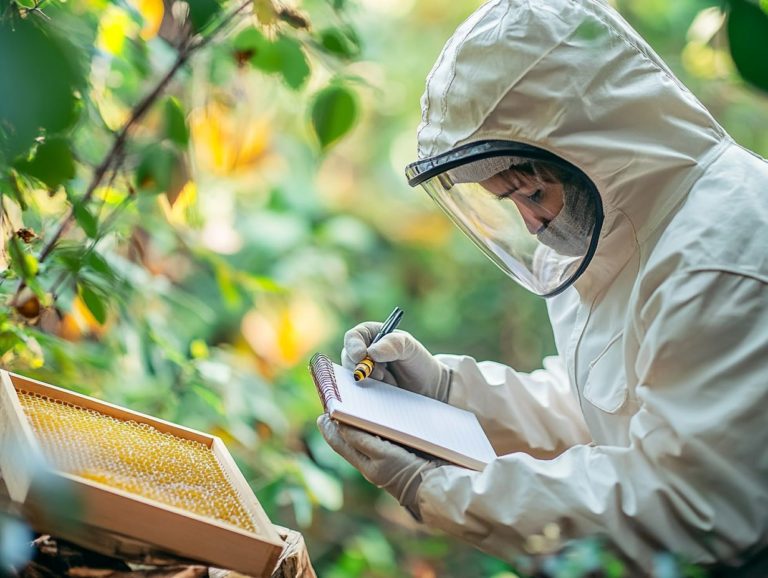Understanding the Role of Wax in Hives
Beeswax and honeycomb are vital elements in the intricate world of bees. They form the foundation for hive functionality and bee health. This article explores how bees produce beeswax. It highlights its key roles in building hives, storing food, and regulating temperature.
Discover how beeswax acts as a powerful shield against pests and diseases, its significance in honey production, and its diverse applications across various industries, including cosmetics and food production with organic beeswax.
Whether you’re an aspiring beekeeper or simply curious about these remarkable substances, there s a wealth of knowledge waiting for you regarding the essential role of wax in nurturing vibrant, healthy hives.
Contents
Key Takeaways:
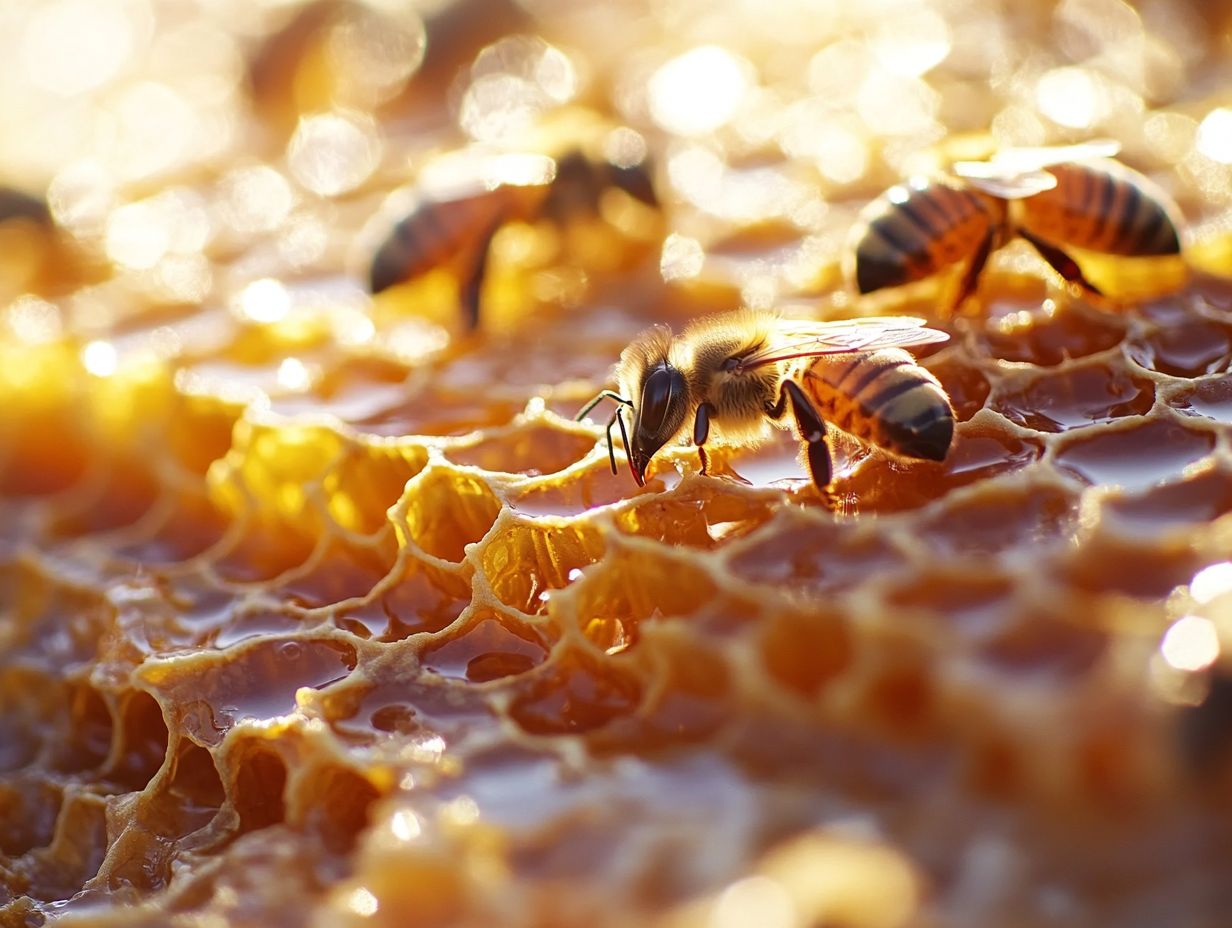
- Beeswax and honeycomb are essential components of a hive, serving as the building blocks for its structure and food storage. The use of wax foundation helps enhance the hive’s structural integrity.
- Wax plays a crucial role in maintaining hive function, from construction to temperature regulation, and protecting against pests and diseases. The wax coating acts as a protective layer and aids in colony protection.
- Beeswax is important for bees and has various uses in other industries, such as cosmetics and food production. Beeswax candles and cheese wax are notable examples of its diverse applications.
The Basics of Beeswax and Honeycomb
Beeswax and honeycomb are fundamental elements in the art of beekeeping. They play pivotal roles in both honey production and the well-being of bee colonies. Beeswax, a natural secretion from worker bees, is crafted into the intricate six-sided shapes of honeycomb. Wax scales produced by worker bees are shaped into the honeycomb structure.
This structure not only serves as a reservoir for honey but also provides a nurturing environment for bees to rear their young. Beeswax and honeycomb work together to keep the colony thriving!
What is Beeswax?
Beeswax is a remarkable natural wax produced by honeybees, specifically secreted from glands in worker bees. You ll quickly appreciate its incredible properties and versatility across a range of applications, from natural balms and creams to beeswax candles.
This fascinating substance is primarily composed of long-chain fatty acids and esters, which give it a unique texture and impressive stability. The production process is quite the marvel: bees meticulously build hexagonal cells in their hive, secreting wax flakes that they shape using their own heat and labor. The hexagon shape optimizes space and structural integrity.
Unlike synthetic alternatives that often harbor harmful chemicals, natural beeswax is free from toxins and fully biodegradable. This makes it an ideal choice for environmentally-conscious consumers like you.
The applications of beeswax are vast, spanning multiple industries. In cosmetics, it s highly valued for creating natural balms and creams. It also plays a crucial role in food storage solutions, such as wraps that keep products fresh without resorting to plastic. Beeswax is also essential for making candles.
By choosing organic beeswax, you support sustainable beekeeping practices and opt for a safe, non-toxic alternative in your daily life. This ensures you make healthier choices for yourself and the planet.
Have you ever wondered how bees create their intricate hives? Explore the wonders of beeswax today and make eco-friendly choices for a better tomorrow!
What is Honeycomb?
Honeycomb is a remarkable structure crafted from beeswax, featuring hexagon-shaped cells that bees carefully build for storing honey, pollen, and nurturing their young.
The honeycomb structure is integral to beekeeping practices and honey storage. This extraordinary architectural achievement is vital to the beekeeping ecosystem. It not only offers a secure and organized haven for developing bee larvae but also optimizes the collection and storage of honey. The hexagonal design is a marvel of space and efficiency, allowing bees to deposit excess nectar and dry it to turn it into honey. Honeycomb serves as an essential food source, packed with vitamins and enzymes crucial for the well-being of the colony.
For beekeepers like you, honeycomb is a treasure trove of nutritional benefits, symbolizing a fruitful harvest and a flourishing bee population. It beautifully illustrates the interdependent relationship between bees and their environment, showcasing the delicate balance of nature at work.
The Importance of Wax in Hive Function
Wax is crucial to the functionality of a beehive, serving numerous purposes that significantly enhance the colony’s survival and efficiency. It acts as a protective coating and helps regulate internal conditions. Using wax correctly in hive maintenance is essential for sustaining a thriving bee population.
The proper application of wax plays a vital role in the hive’s overall health and productivity.
How is Wax Produced in the Hive?
Wax production is an amazing process that worker bees perform daily! These industrious little creatures secrete wax from specialized glands on their abdomens, shaping it into tiny wax scales. This incredible process not only showcases the bees’ remarkable adaptability but also underscores their dependence on specific dietary elements, such as pollen and nectar. Bees’ diet directly influences the quality and quantity of wax production.
The composition of their diet plays a pivotal role in determining both the quality and quantity of wax they produce. Environmental factors, including temperature and humidity, significantly impact wax yield; warmer conditions often lead to higher secretion rates. Beekeepers can use wax dipping to enhance the durability of wooden beehives.
By improving these conditions, you can ensure a steady supply of wax, which is essential for constructing brood cells, storing honey, and maintaining the overall health of the hive.
What is the Role of Wax in Hive Construction?
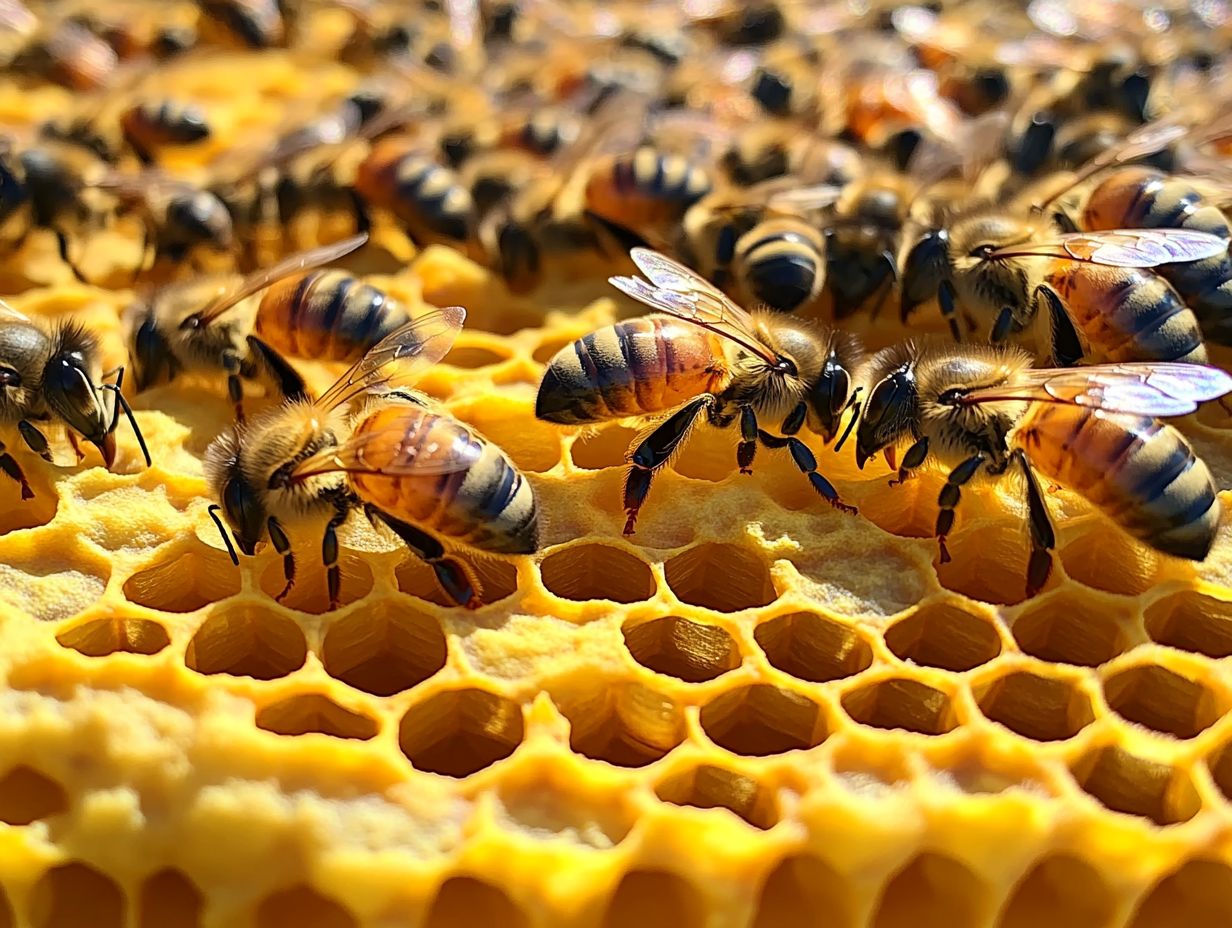
In hive construction, wax is your go-to building material for honeycomb. Bees work meticulously to shape it into hexagonal cells that provide both structural integrity and ample space for storing honey and brood. Wax adhesion is critical for maintaining the comb’s structure.
This design maximizes storage efficiency and strengthens the hive. During your hive inspections, make sure to check your beeswax comb regularly! It’s vital for the colony’s success. Look for signs of wear, damage, or pest infestations that could jeopardize the integrity of the comb. Proper comb construction ensures the long-term sustainability of the hive.
Regular maintenance, including cleaning and replacing old or broken comb, is essential. This ensures that the bees have a safe and efficient workspace, fostering a thriving population and enhancing honey production.
How Does Wax Help Store Food?
Wax is crucial in food storage, especially in beekeeping. It helps preserve honey and keeps stored products safe.
The unique properties of wax make it perfect for preserving honey. Bees use wax to seal their hives, protecting the honey from outside elements and keeping its flavor intact.
Embracing sustainable beekeeping practices highlights the importance of this natural resource. By relying on organic methods and avoiding synthetic materials, you ensure that your honey remains safe for consumption while promoting ecological balance.
What is the Role of Wax in Temperature Regulation?
Wax plays a vital role in temperature control within the hive. It ensures that the internal environment remains stable, which is essential for the health and productivity of your bee colony.
When faced with extreme weather, bees use wax’s insulating properties to create a protective seal. They engage in behaviors like clustering to maintain a consistent internal temperature despite external changes.
During colder months, bees adapt their diet to include more high-energy food sources. This ensures they have the fuel required for effective temperature control.
The Role of Wax in Bee Health
Wax is essential for maintaining the health of your bees. It provides protective benefits against pests and diseases while enhancing the overall vitality of the colony.
How Does Wax Help Protect Against Pests and Diseases?
Wax is key in the protective strategies bees use against pests and diseases. It forms a crucial barrier that prevents infestations from harmful invaders like the varroa mite.
This remarkable substance creates a nurturing environment for bees. It fosters the growth of beneficial microorganisms that combat pathogens, helping to minimize disease spread.
As a beekeeper, maintaining a chemical-free environment is vital. This approach enhances wax’s protective qualities and supports the overall health of the bees, ensuring a thriving ecosystem within the colony.
What is the Impact of Wax on Honey Production and Honey Storage?
The presence of beehive wax has a direct impact on honey production, as it forms the comb structures where honey is stored and plays an essential role in the processes of honey collection and storage carried out by the bees.
Without beehive wax, the diligent efforts of worker bees would be significantly hampered, as they depend on this substance to create hexagonal cells that not only hold honey but also provide a secure environment for the development of larvae. The wax is secreted by specialized glands in the worker bees, and its production is a metabolic process. Essentially, the quantity of wax produced is closely linked to the overall honey yield; sufficient wax facilitates efficient storage and organization of honey, allowing the colony to thrive even in times of flower scarcity. Additionally, the hexagon shape of the cells is ideal for maximizing space and strength within the hive.
Thus, the relationship between beeswax production and honey yield is crucial, highlighting the importance of these tiny structures for both the survival of the bees and the sustainability of the honey industry. Effective beekeeping practices must consider this dynamic to ensure high-quality bee colonies.
The Use of Beeswax in Other Industries
Beeswax, particularly natural beeswax, is celebrated for its myriad applications beyond the beehive. Its chemical-free and sustainable qualities make it a preferred choice across various sectors.
Beeswax is a remarkably versatile material that you can utilize not just in beekeeping but across a multitude of industries. Its applications span from crafting natural candles to formulating cosmetics, all while highlighting its chemical-free and sustainable qualities. The benefits of beeswax also extend to its use in creating protective coatings for various surfaces.
What Products Use Beeswax?
Products that often feature beeswax include beeswax candles, natural cosmetics, and eco-friendly food wraps, all of which take advantage of its chemical-free and sustainable properties. Additionally, beeswax is used in cheese wax to provide a protective coating for artisanal cheeses.
Beyond these popular items, beeswax graces lip balms, healing salves, and wooden furniture polish, demonstrating its remarkable versatility across a broad spectrum of applications. Other notable uses include wax dipping for enhanced durability of products and wax foundation in beekeeping. These products not only elevate your personal care routine and enhance the aesthetics of your home, but they also reflect a commitment to environmentally conscious practices.
By choosing beeswax products, you positively impact your health by steering clear of the synthetic chemicals typically found in conventional alternatives. Moreover, the antimicrobial properties inherent in beeswax contribute to its appeal for health-conscious individuals.
Embracing beeswax fosters sustainability; it s a renewable resource that supports beekeeping, a crucial practice for maintaining ecological balance. This dedication to natural choices ultimately paves the way for a healthier lifestyle while safeguarding our planet for future generations.
How is Beeswax Harvested and Processed?
The careful harvesting and processing of beeswax ensure sustainability and preserve its chemical-free integrity. Sustainable beekeeping practices are essential for maintaining healthy bee colonies amid environmental challenges.
You typically begin this thoughtful process by gently removing the honey-filled combs. This requires minimizing disturbance to the bee colonies.
A hot air knife, a special tool that uses hot air to cut wax caps, is often employed to cut away the caps from the honey cells. This step allows the honey to flow out effortlessly and maintains the integrity of both the honey and wax.
Once the honey is extracted, the beeswax undergoes filtration to eliminate impurities. The result is a pristine, golden substance ready for various applications.
The resulting wax can be used in numerous products due to its ideal viscosity and adhesive properties. Embracing sustainable beekeeping practices is crucial.
These practices include leaving enough honey for the bees and using organic treatments for pest management. They help keep bee populations healthy, ensuring they can produce high-quality beeswax for years.
Proper beehive maintenance and pest control are key to supporting colony protection and overall beekeeping success.
Discover the Surprising Benefits and Challenges of Beeswax in Everyday Products!
The benefits of incorporating beeswax across various industries are compelling, particularly its sustainability and chemical-free composition. However, it’s crucial to consider sourcing concerns and alternatives like paraffin wax and microcrystalline wax.
Each type of wax has its benefits and drawbacks, from ease of use to environmental impact. Many industries are increasingly embracing beeswax for its natural properties.
Beeswax offers a healthier choice and reinforces eco-friendly practices. Unlike paraffin wax, which comes from petroleum, beeswax is biodegradable and has a considerably lower environmental footprint.
Although microcrystalline wax provides some versatility, it cannot compete with the natural antimicrobial properties and delightful fragrance of beeswax. In the creation of an attractive beehive, natural beeswax is unmatched.
However, sourcing beeswax presents challenges. These include habitat disruption for bees and the necessity of ethical beekeeping practices.
When evaluating wax options, it s essential to weigh the appealing benefits of beeswax against the sustainability and ethical considerations of its sourcing. Some alternatives, like blended waxes, offer different balances of properties and environmental impacts.
How to Support Healthy Wax Production in Hives
Supporting healthy beeswax production in your hives is crucial for enhancing the overall health and productivity of your colonies. Effective beehive maintenance, including regular inspections and proper temperature management, plays a pivotal role in this process.
By implementing effective hive maintenance strategies, you can ensure that your bees thrive and produce the best possible results!
What Factors Affect Wax Production in Hives?
Several factors influence beeswax production in your hives, including the diet of your worker bees, environmental conditions, and the overall health of your colony. Effective management of these elements ensures optimal wax durability and adhesion, which are essential for the honeycomb structure.
Nutrition plays a crucial role in bees’ ability to make wax effectively. A balanced diet rich in essential nutrients such as proteins, carbohydrates, and fats directly impacts the productivity of your bees. Ensuring your bees have access to ample nectar and pollen is vital for their overall health and wax production.
Weather can present significant challenges. Ideal temperatures and humidity levels are necessary for effective wax production. If conditions become too extreme, it may hinder your bees’ ability to produce wax. Beekeepers should monitor hive temperature and environmental conditions closely to mitigate these effects.
Implementing effective hive management practices, like regular inspections and maintaining a clean environment, will help ensure that your bees remain healthy and capable of performing their essential tasks. This approach ultimately fosters optimal beeswax production. Incorporating methods to maintain the quality of the comb also helps sustain high wax output.
How Can Beekeepers Encourage Healthy Wax Production?
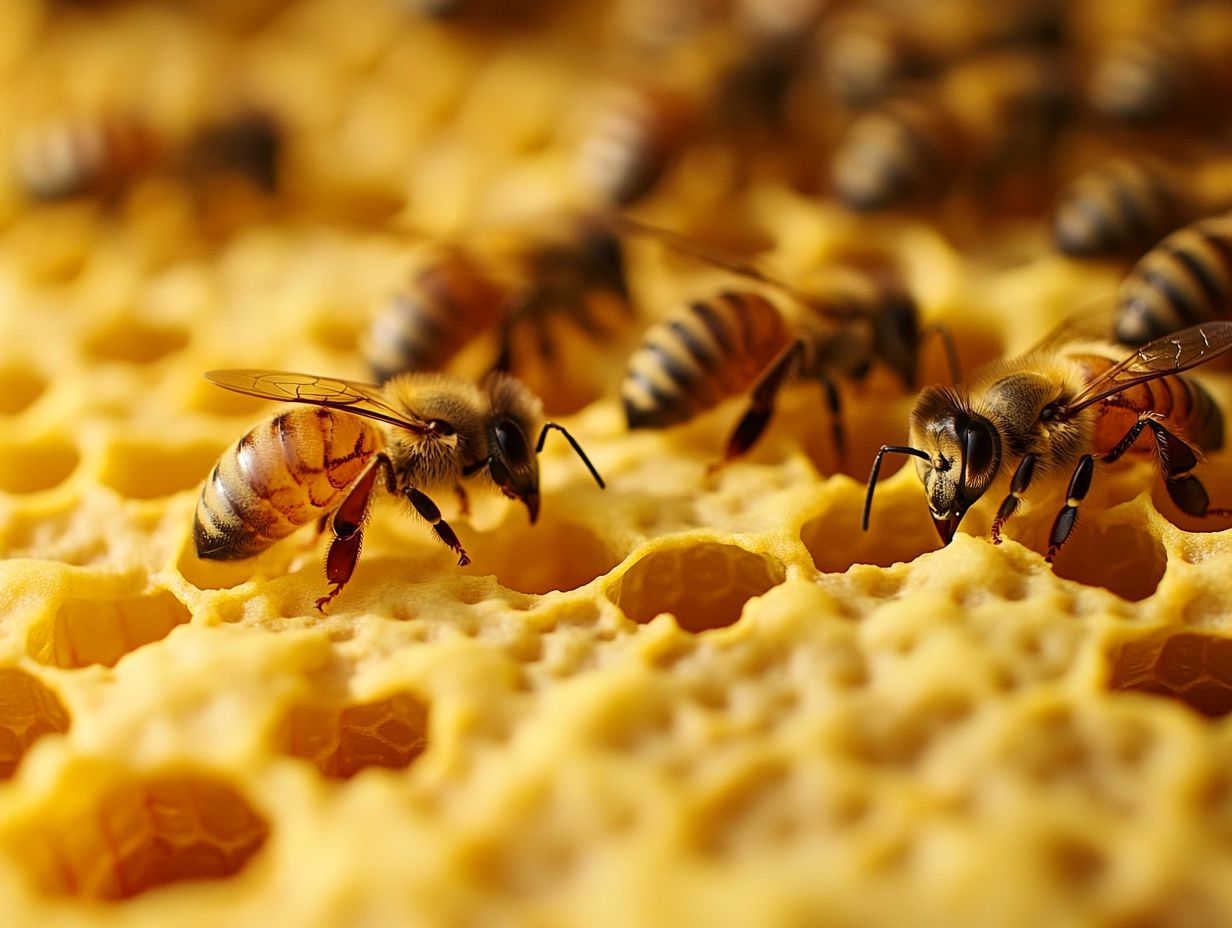
Boost your bees’ wax production with smart hive management! Thoughtful hive management practices that consider environmental factors can optimize conditions for your bee colonies. Sustainable beekeeping practices promote long-term health and productivity.
By conducting regular hive inspections, you can proactively spot and address issues that may hinder wax production, including pests, diseases, and overall colony health. Creating a stable and nurturing environment is essential. This means ensuring that foraging resources are plentiful and that the microclimate which refers to the unique climate conditions inside the hive supports the bees’ activities. Implementing effective pest management strategies is also crucial for maintaining colony health.
Use methods like sterilizing old combs and replacing them with fresh ones. These practices lower disease risk and create better conditions for wax production. Together, these strategies not only promote healthy colony growth but also enhance the overall productivity of your bees in their wax-making endeavors. Wax foundation is a key element in these practices, providing a stable base for comb construction.
Frequently Asked Questions
What is the role of wax in beehives?
Wax is essential for building and maintaining beehives. It is used by bees to construct the hexagonal cells that make up the hive structure. This beeswax comb is crucial for storing honey and rearing young bees.
How is wax produced by bees?
Wax is produced by special glands on the underside of a bee’s abdomen. These glands secrete tiny flakes of wax scales, which are then chewed and molded by the bees into honeycomb cells. The wax melting point and wax viscosity are critical to this process, allowing for efficient comb construction and maintenance.
What are the functions of wax in a beehive?
Wax provides the structural framework of the hive and serves as a storage unit for honey and pollen. It also acts as a protective barrier against outside elements and pests. The natural properties of beeswax, including its antimicrobial properties, enhance its role in colony protection.
Do all bees produce wax?
No, only female worker bees have the glands necessary for producing wax. Male drones do not have these glands and therefore do not produce wax. Effective beekeeping practices prioritize the health and productivity of worker bees to maximize wax output and overall hive efficiency.
How do bees keep their wax clean?
Bees maintain the cleanliness of their wax by using propolis, a resinous substance collected from plants. They coat the wax cells with propolis, which has germ-fighting properties, to prevent the growth of harmful germs. Effective beeswax application in the hive helps ensure a clean and healthy environment for honey production.
Can wax be reused by bees?
Yes! Bees can recycle and reuse their wax. When honeycomb cells become old or damaged, bees quickly clean them out.
They recycle the wax to build new cells. This remarkable recycling ability is vital for keeping the hive strong and healthy!

